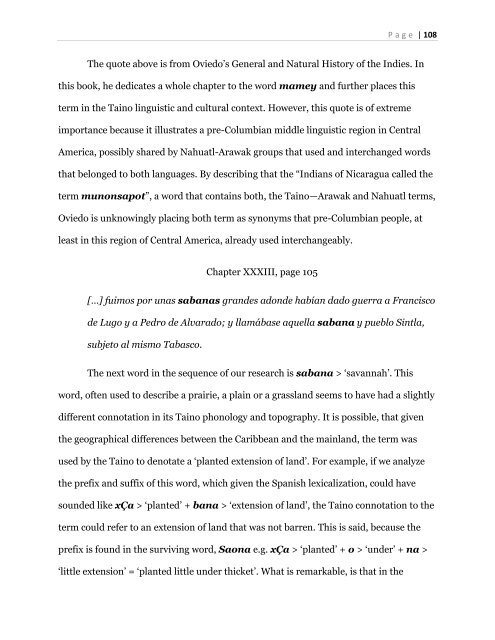Language of the Voiceless: Traces of Taino Language, Food, and Culture in the Americas From 1492 to the Present
by Leonardo Nin
by Leonardo Nin
You also want an ePaper? Increase the reach of your titles
YUMPU automatically turns print PDFs into web optimized ePapers that Google loves.
P a g e | 108<br />
The quote above is from Oviedo’s General <strong>and</strong> Natural His<strong>to</strong>ry <strong>of</strong> <strong>the</strong> Indies. In<br />
this book, he dedicates a whole chapter <strong>to</strong> <strong>the</strong> word mamey <strong>and</strong> fur<strong>the</strong>r places this<br />
term <strong>in</strong> <strong>the</strong> <strong>Ta<strong>in</strong>o</strong> l<strong>in</strong>guistic <strong>and</strong> cultural context. However, this quote is <strong>of</strong> extreme<br />
importance because it illustrates a pre-Columbian middle l<strong>in</strong>guistic region <strong>in</strong> Central<br />
America, possibly shared by Nahuatl-Arawak groups that used <strong>and</strong> <strong>in</strong>terchanged words<br />
that belonged <strong>to</strong> both languages. By describ<strong>in</strong>g that <strong>the</strong> “Indians <strong>of</strong> Nicaragua called <strong>the</strong><br />
term munonsapot”, a word that conta<strong>in</strong>s both, <strong>the</strong> <strong>Ta<strong>in</strong>o</strong>—Arawak <strong>and</strong> Nahuatl terms,<br />
Oviedo is unknow<strong>in</strong>gly plac<strong>in</strong>g both term as synonyms that pre-Columbian people, at<br />
least <strong>in</strong> this region <strong>of</strong> Central America, already used <strong>in</strong>terchangeably.<br />
Chapter XXXIII, page 105<br />
[…] fuimos por unas sabanas gr<strong>and</strong>es adonde habían dado guerra a Francisco<br />
de Lugo y a Pedro de Alvarado; y llamábase aquella sabana y pueblo S<strong>in</strong>tla,<br />
subje<strong>to</strong> al mismo Tabasco.<br />
The next word <strong>in</strong> <strong>the</strong> sequence <strong>of</strong> our research is sabana > ‘savannah’. This<br />
word, <strong>of</strong>ten used <strong>to</strong> describe a prairie, a pla<strong>in</strong> or a grassl<strong>and</strong> seems <strong>to</strong> have had a slightly<br />
different connotation <strong>in</strong> its <strong>Ta<strong>in</strong>o</strong> phonology <strong>and</strong> <strong>to</strong>pography. It is possible, that given<br />
<strong>the</strong> geographical differences between <strong>the</strong> Caribbean <strong>and</strong> <strong>the</strong> ma<strong>in</strong>l<strong>and</strong>, <strong>the</strong> term was<br />
used by <strong>the</strong> <strong>Ta<strong>in</strong>o</strong> <strong>to</strong> denotate a ‘planted extension <strong>of</strong> l<strong>and</strong>’. For example, if we analyze<br />
<strong>the</strong> prefix <strong>and</strong> suffix <strong>of</strong> this word, which given <strong>the</strong> Spanish lexicalization, could have<br />
sounded like xÇa > ‘planted’ + bana > ‘extension <strong>of</strong> l<strong>and</strong>’, <strong>the</strong> <strong>Ta<strong>in</strong>o</strong> connotation <strong>to</strong> <strong>the</strong><br />
term could refer <strong>to</strong> an extension <strong>of</strong> l<strong>and</strong> that was not barren. This is said, because <strong>the</strong><br />
prefix is found <strong>in</strong> <strong>the</strong> surviv<strong>in</strong>g word, Saona e.g. xÇa > ‘planted’ + o > ‘under’ + na ><br />
‘little extension’ = ‘planted little under thicket’. What is remarkable, is that <strong>in</strong> <strong>the</strong>


















